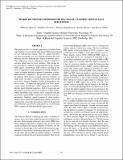| dc.contributor.author | Shariat, Shahriar | |
| dc.contributor.author | Pavlovic, Vladimir | |
| dc.contributor.author | Papathomas, Thomas | |
| dc.contributor.author | Braun, Ainsley | |
| dc.contributor.author | Sinha, Pawan | |
| dc.date.accessioned | 2012-04-19T18:51:37Z | |
| dc.date.available | 2012-04-19T18:51:37Z | |
| dc.date.issued | 2010-08 | |
| dc.identifier.isbn | 978-1-4244-7876-7 | |
| dc.identifier.isbn | 978-1-4244-7875-0 | |
| dc.identifier.issn | 1551-2541 | |
| dc.identifier.other | INSPEC Accession Number: 11576323 | |
| dc.identifier.uri | http://hdl.handle.net/1721.1/70068 | |
| dc.description.abstract | This paper presents a systematic application of machine learning techniques for classifying high-density EEG signals elicited by face and non-face stimuli. The two stimuli used here are derived from the vase-faces illusion and share the same defining contours, differing only slightly in stimulus space. This emphasizes activity differences related to high-level percepts rather than low-level attributes. This design decision results in a difficult classification task for the ensuing EEG signals. Traditionally, EEG analyses are done on the basis of signal processing techniques involving multiple instance averaging and then a manual examination to detect differentiating components. The present study constitutes an agnostic effort based on purely statistical estimates of three major classifiers: L1-norm logistic regression, group lasso and k Nearest Neighbors (kNN); kNN produced the worst results. L1 regression and group lasso show significantly better performance, while being abl e to identify distinct spatio-temporal signatures. Both L1 regression and group lasso assert the saliency of samples in 170ms, 250ms, 400ms and 600ms after stimulus onset, congruent with the previously reported ERP components associated with face perception. Similarly, spatial locations of salient markers point to the occipital and temporal brain regions, previously implicated in visual object perception. The overall approach presented here can provide a principled way of identifying EEG correlates of other perceptual/cognitive tasks. | en_US |
| dc.language.iso | en_US | |
| dc.publisher | Institute of Electrical and Electronics Engineers | en_US |
| dc.relation.isversionof | http://dx.doi.org/10.1109/MLSP.2010.5589166 | en_US |
| dc.rights | Article is made available in accordance with the publisher's policy and may be subject to US copyright law. Please refer to the publisher's site for terms of use. | en_US |
| dc.source | IEEE | en_US |
| dc.title | Sparse dictionary methods for EEG signal classification in face perception | en_US |
| dc.type | Article | en_US |
| dc.identifier.citation | Shariat, Shahriar et al. “Sparse Dictionary Methods for EEG Signal Classification in Face Perception.” IEEE, 2010. 331–336. Web. ©2010 IEEE. | en_US |
| dc.contributor.department | Massachusetts Institute of Technology. Department of Brain and Cognitive Sciences | en_US |
| dc.contributor.approver | Sinha, Pawan | |
| dc.contributor.mitauthor | Shariat, Shahriar | |
| dc.contributor.mitauthor | Pavlovic, Vladimir | |
| dc.contributor.mitauthor | Braun, Ainsley | |
| dc.contributor.mitauthor | Sinha, Pawan | |
| dc.relation.journal | Proceedings of the 2010 IEEE International Workshop on Machine Learning for Signal Processing (MLSP 2010) | en_US |
| dc.eprint.version | Final published version | en_US |
| dc.type.uri | http://purl.org/eprint/type/ConferencePaper | en_US |
| dspace.orderedauthors | Shariat, Shahriar; Pavlovic, Vladimir; Papathomas, Thomas; Braun, Ainsley; Sinha, Pawan | en |
| dc.identifier.orcid | https://orcid.org/0000-0002-8259-7079 | |
| mit.license | PUBLISHER_POLICY | en_US |
| mit.metadata.status | Complete | |
